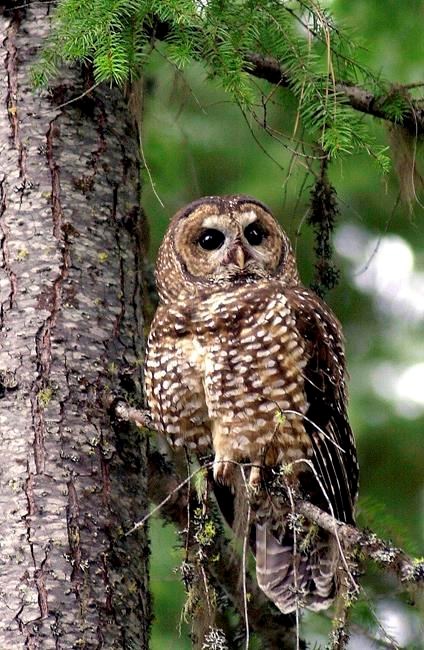VANCOUVER — A Federal Court judge said he's "wrestling" with why the minister responsible for saving British Columbia's northern spotted owl waited eight months to recommend an emergency protection order to cabinet with only one wild-born bird remaining.
Judge Yvan Roy questioned federal government lawyer Aileen Jones during a hearing on Thursday over Ottawa's effort to protect the endangered species, asking why Environment Minister Steven Guilbeault made his recommendation to cabinet in late September despite saying he would take that action in January.
Jones replied that the delay was necessary because the Canadian Species at Risk Act should be interpreted "in a way that the minister can make an informed recommendation to cabinet."
Jones told the court that using only scientific evidence on a potential emergency order "undermines" the collaboration needed between the federal and provincial governments to protect the owls, and Guilbeault needed to balance other factors such as social-economic considerations that are "equally relevant."
"It's not as simple as taking a recommendation and turning it into an order," she said.
"The imminence of the threat is not the only thing guiding the timeline. The complexity of the order requires additional time, even if some of the imminent threat have begun to materialize," she said.
There is only one known wild spotted owl, a female, in the area of B.C.'s Fraser Canyon that was being considered for protection. Two male owls raised in captivity were also recently released.
The hearing was in response to a legal challenge by the environmental group Wilderness Committee, which argued Guilbeault took too long between deciding to recommend an emergency order to protect the owls and taking it to cabinet.
The federal government announced earlier this month that it would not go ahead with the order, despite Guilbeault's recommendation.
Roy questioned the government lawyer's characterization of the minister's responsibilities under the Species at Risk Act, saying his decision to recommend an order should not be a rolling process without a definitive, reasonable timeline.
"At some point in time, there must be a cutoff point," Roy said.
"Let's say there's one individual (animal) left in the country, and that one individual would be destroyed (if the threat isn't addressed)," he said. "It seems to me the minister would have an obligation to go to cabinet immediately."
Jones said Guilbeault has the obligation to engage with the province on any order that would restrict logging in spotted owl habitat, noting Ottawa needed to determine the proper "scope" of a potential emergency order to ensure the species' recovery.
"It's not good for the spotted owl to prevent logging in areas where logging already took place," Jones said.
Jones also told the court that a 2006 imminent-risk assessment for B.C.'s spotted owl population yielded a provincial protection plan that limited logging in some habitat areas, a plan that has been updated over the years.
She said while the plan wasn't successful in curtailing the owls' decline, it did address "the science-based imminent threat" that was identified in the assessment and protected some old-growth forest that the species depends for survival.
"We would characterize that as success because no emergency order was required to protect the habitat identified," Jones said.
Roy, in response, expressed doubt over Jones's assertion, noting statistics showed there were 22 wild spotted owls in the province in 2006.
"You had 22 individuals in 2006, and we end up with one in 2023," he said. "How is that a success?"
Ultimately, Jones said the federal process and responsibilities under the Canadian Species at Risk Act should be interpreted with the legislation's core objective — something that could not be achieved without partnership with the province.
"Is it going to be good for the recovery of the species?" she said
The protection of current and future habitats requires provincial consultation, given that the land is in B.C.'s jurisdiction, she added.
The spotted owl holds cultural significance for several B.C. First Nations, which regard the animal as a messenger for the health of its old-growth ecosystem.
The province has estimated there were at one-time up to 1,000 spotted owls in B.C.
Chief James Hobart of Spuzzum First Nation in the Fraser Canyon attended the hearings in Vancouver and said the accounts of government actions while the spotted owl population dwindled made him angry, confused and frustrated.
"My blood was boiling because so many opportunities were there for them to do the right thing," Hobart said outside court. "We shouldn't get to a point where we're still having to talk when they're down to one bird that is in the wild."
The Wilderness Committee has said the last known wild-born spotted owl in B.C. resides in Spuzzum territory.
Hobart said his community is keeping a close eye on any developments in the case and other government actions affecting B.C.'s ecosystems to decide what to do next.
Roy has ordered both the Crown and the Wilderness Committee represented by environmental law charity Ecojustice to give additional written submissions on their positions in the next four weeks to aid in reaching a decision.
This report by The Canadian Press was first published Oct. 19, 2023.
Chuck Chiang, The Canadian Press



